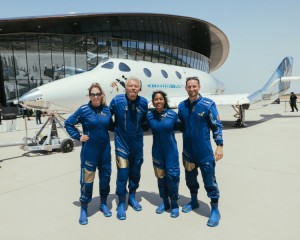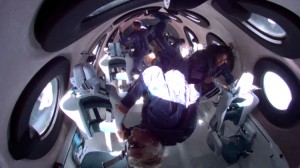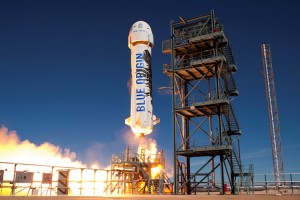Bezos Blasts Off Behind Branson in Billionaires’ Battle
Tuesday, July 20th, 2021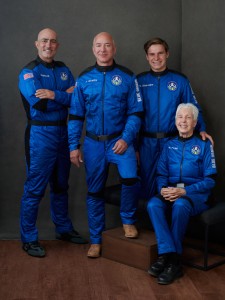
American businessman Jeff Bezos poses with the other passengers New Shepard’s first crewed flight to space. From left to right: Mark Bezos, American executive; Jeff Bezos, founder of Blue Origin; Oliver Daemen, Dutch physics student; and Wally Funk, American pilot and aviation expert. Credit: © Blue Origin
The world’s richest man, his brother, an 82-year old woman, and a physics student sealed themselves up in a tiny capsule and flew into space. This might sound like the setup of a joke, but that’s what happened today. American businessman Jeff Bezos flew to space with three companions in the first crewed flight of the New Shepard rocket, developed by Bezos’s aerospace company Blue Origin. Their flight came exactly 52 years after the Apollo 11 moon landing.
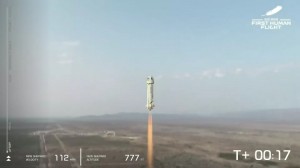
The New Shepard rocket takes off on July 20 carrying its first group of passengers. Both the booster and the capsule landed back near the launch pad about 10 minutes later.
Credit: © Blue Origin
The rocket, a small reusable booster and capsule called New Shepard, took off this morning from Texas. New Shepard is named after Alan Shepard, the first American to reach space. The rocket rose more than 100 miles (61 kilometers) straight into the air. The booster separated from the capsule and landed using its engines. The capsule floated back down to the ground on parachutes. The whole flight lasted about 10 minutes. Along for the ride were Bezos’ brother Mark, the American aerospace pioneer Mary Wallace “Wally” Funk, and 18-year-old physics student Oliver Daemen.
Bezos, who made billions from his online shopping company Amazon, founded Blue Origin in 2000. The company spent years developing and testing the New Shepard rocket. In 2015 a New Shepard rocket reached the edge of space and then returned safely to Earth, landing vertically. It was the first rocket to do so, narrowly beating the first successful landing of SpaceX’s much larger Falcon 9 by less than a month.
The participants of the New Shepard flight set multiple records. But Bezos lost out on his own record, however. Until a couple of weeks ago, it appeared that he was going to be the first mogul to fly to space aboard his own spacecraft. But that honor instead went to the British businessman Richard Branson, who flew on a spaceplane of his own space tourism company. The July 11 mission was originally scheduled to be a test flight, but Branson added himself to the manifest after Blue Origin announced Bezos’s flight.
Wally Funk trained as an astronaut in the 1960’s. She was part of a privately-funded program that subjected women to the same testing and training as the men who became part of the United States’ Mercury Program. Although these women, later known as the Mercury 13, were not permitted to become astronauts, Funk never quit on her dream of going to space. Earlier this year, Bezos surprised Funk with a seat on the inaugural crewed flight. At 82, she became the oldest person to go to space. She surpassed the American astronaut and senator John Glenn, who returned to space in 1998 at the age of 77 aboard the space shuttle.
Oliver Daemen became the youngest person to go to space. He surpassed the American astronaut Sally Ride, who was 32 when she flew aboard the space shuttle Challenger in 1983. Daemen also became the first paying space tourist to fly aboard a privately-developed spacecraft. A handful of tourists have gone to space already. But all of these were aboard Soyuz rockets developed and launched by the Russian government. Only Virgin Galactic employees flew aboard Branson’s flight.
This fourth seat was highlighted by profligate spending, mystery, and intrigue. Blue Origin put up the seat for auction, with the money being donated to the company’s charity. An anonymous bidder paid $28 million for the seat. But last week, the company announced that the bidder had a scheduling conflict and would go on a later flight instead. Blue Origin offered the seat to Dutch investor Joes Daemen, who had purchased a seat for a later Blue Origin flight. He gave the seat to his son, Oliver.
Blue Origin will start offering rides to other paying customers soon. Although the Billionaire’s Space Race is over, the battle for control of the space tourism market is just beginning.

